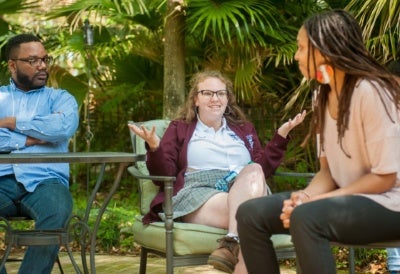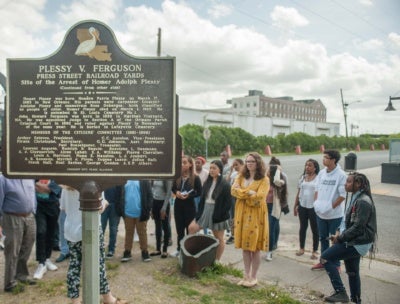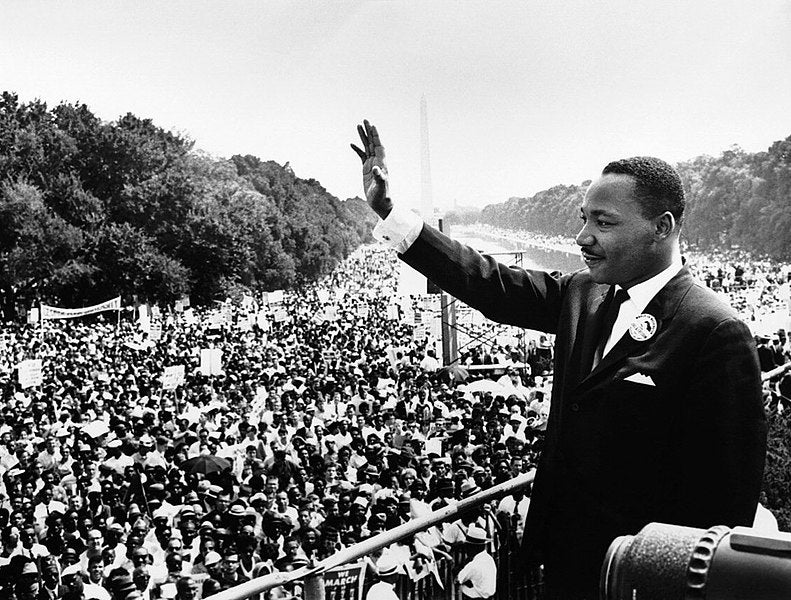Since the horrific shooting at Marjory Stoneman Douglas High School in Parkland, Florida, we’ve been reminded of the tremendous power of young people to invest themselves in the issues they care about to spark change. As thousands organized to lead and take part in March for Our Lives demonstrations across the country last Saturday, students from 14 high schools across New Orleans came together through the AspenX program to explore the history of race in southeast Louisiana and inspire each other to lead solutions to racial inequities.
AspenX is a two-day program during which high school students immerse themselves in critical issues of the day through virtual and experiential learning coupled with expert-moderated in-person dialogue.
Students began day one with experiential learning at Le Musée de f.p.c., where McKenna Museum curatorial manager and education specialist Kimberly Coleman led a guided tour of one of the nation’s few attractions dedicated exclusively to preserving the materials culture of and telling the story of free people of color. During the tour and discussion that followed, students learned how free people of color enjoyed relative prosperity – owning more than $2 million worth of property and enslaved Catholics benefited from favorable laws under Louisiana’s Code Noir during the Antebellum period, and that Louisiana produced the United States’ first African American governor in the early years of Reconstruction.

Photo by Leslie Gamboni
Reflecting on their lived experiences, students were asked to consider how and why African Americans in the region have been largely stripped of those levels of wealth and prosperity today.
The next stop in the experiential learning module brought the group to New Orleans City Park for a trip to the New Orleans Museum of Art (NOMA). At NOMA, students were treated to a guided tour of Carlos Rolón’s Outside/In exhibition by the artist himself, organized by NOMA modern and contemporary art curator Katie Pfohl. Internationally recognized for pieces that break down walls of division, Rolón works with shattered glass, wrought iron, and cinder blocks to repurpose materials typically associated with barriers to access to create new points of entry for viewers.
During the tour and over dinner, Rolón provided insights to his creative process, sharing his intentions for his work to shine light on current social issues and connect disparate groups across culture, time, and space by encouraging dialogue around race and equity on a global scale.
Rolón emphasized the importance of being proud of one’s self and history and shared a story of personal discovery around appropriation versus appreciation. He recalled feeling unwelcome in museums as a young person of color, which spurred a discussion among the group about where they feel most comfortable with their identities and what creative outlets they use to express themselves.
On day two, students convened inside the New Orleans Center for Creative Arts’ Marsalis Jazz Studio to build and reflect on the prior day’s learning in the broader context of race and equity in the US. Fellowship for Race & Equity in Education founder and CEO Michelle Molitor led the conversation to help the group unpack beliefs and assumptions around their lived experiences.
The first module took students through an overview of the US’ history of racial oppression and inequity. The resulting discussion centered around how aspects of that history seem as present and relevant today as they did decades and centuries ago.
The NET Charter High School junior Katelyn Jones shared feeling like “the [American] prison system is the new slavery or Jim Crow,” further elaborating that the infamous Louisiana State Penitentiary at Angola is a plantation turned prison where the state still profits off manual, often unpaid labor. St. Mary’s Dominican High School junior Breanne Mitchell spoke to the cyclical nature of the system and its lasting effects on families and communities, Ursuline Academy senior Reagan Ulrich voiced disapproval for the system’s orientation towards punishment as opposed to rehabilitation, and Lusher Charter School junior Ben Burstain questioned the legitimacy of a system that preys on the less fortunate and rewards those with means. New Orleans Charter Science and Mathematics High School sophomore Jeysi Guillen added that we’ve changed the names, but preserved the practices.
The group ended this module with a reading of Elizabeth C. Leung’s “My Country ‘Tis Not of Thee,” which chronicles her never-ending journey to understand her identity as an Asian American female, navigating between feeling too Asian to be truly American, but too American to be accepted back in her native country. Many shared stories of experiences like Leung’s – feeling confused and often conflicted, and having third parties try to dictate what their identities can and cannot be.
With a local March for Our Lives demonstration set to take place in the afternoon, students were eager to share thoughts and hear each other’s opinions on youth activism and differing perceptions and portrayals of youth-led movements and protests along racial lines.
“[Marjory Stoneman Douglas High School]-led protests highlight the difference in how people of color are perceived,” said Mitchell. “Why are we thugs?”
Citing backlash after NFL players’ peaceful protests of racial injustices during the national anthem, Ulrich added, “it seems like there’s no right way to protest for people of color.”
After lunch, outgoing president and CEO of the Aspen Institute and current Tulane University professor Walter Isaacson joined the group. A New Orleans native and historian, Isaacson shared historical perspectives on race and equity in New Orleans with an eye towards local current events like removal of several of the city’s confederate monuments.
One group of students took the position that if we don’t acknowledge history, we’re doomed to repeat it, to which another replied, the place to do that is in museums. Isaacson agreed with the latter, saying certain aspects of history are “to be remembered, not celebrated,” adding that monuments are erected to convey messages, and the merits of those messages speak to the legitimacy of our monuments, so we should always ask, ‘why?’

Photo by Leslie Gamboni
After drawing inspiration from a visit to and conversation around the plaque marking Homer Plessy’s removal from an East Louisiana Railroad Co. train car in 1892 – which led to the landmark Supreme Court case, Plessy v. Ferguson, that upheld the doctrine of ‘separate but equal’ in 1896 – students brainstormed solutions to racial inequities plaguing their communities.
Ideas included providing spaces for young people to engage in effective civil discourse around important issues in school, common-sense gun control legislation, and measures to move our criminal justice system away from punishment, towards rehabilitation.
Reflecting on the experience, Lusher Charter High School freshman Ali Taher said, “change starts with us,” and he’s absolutely right. The first step to making that change is showing up, setting aside assumptions and biases, and joining the conversation.

